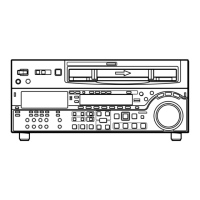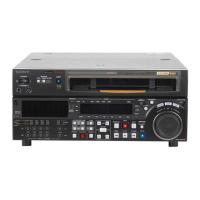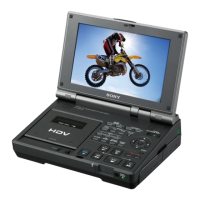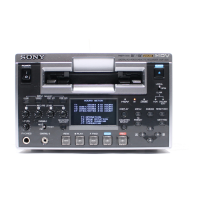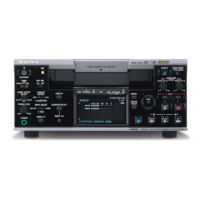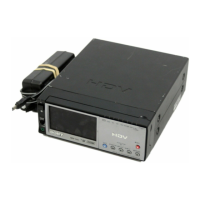Do you have a question about the Sony HDW-1800 and is the answer not in the manual?
Warnings regarding fire/electric shock risk, exposure to rain/moisture, and cabinet opening.
Warning to use only UL LISTED power cords for USA operation, specifying type, length, and rating.
Use approved power cords with earthing and proper ratings conforming to country safety regulations.
Cautions against exposure to dripping/splashing and placing liquid-filled objects on the apparatus.
Statement on Class A digital device compliance with FCC rules for commercial environments.
Product complies with EMC and Low Voltage Directives, conforming to European standards.
Consider operating temperature and maintain adequate space for heat radiation (4cm sides, 10cm rear).
Warning about excessive sound pressure from headphones causing hearing loss.
Instructions for battery disposal in the Netherlands (KCA) and Taiwan battery information.
Overview of HDW-1800/D1800 capabilities, HDCAM format, and high-performance features.
Details on HDCAM format tape, recording time, and signal compression technologies.
Explains digital signal processing (HD 4:2:2) and available interfaces.
Details high-quality 20-bit/48kHz digital audio support and channel configurations.
Details of the LCD control panel, operation buttons, jog/shuttle dial, and function menu.
Overview of editing functions, including Assemble, Insert, DMC, Split, and Cross fade editing.
Explains HD-to-SD Downconverter and SD-to-HD Upconverter functions.
Details remote control interfaces (RS-422A, parallel) and rack mounting options.
Recording i.LINK (HDV) signals from HDV devices onto HDCAM tapes.
Conceptual diagram showing an example system configuration for using the unit.
Explains how to redefine function menu pages and buttons based on factory default settings.
Identifies the three control panels: Upper, Lower, and Switch panels.
Details of the upper control panel: POWER switch, REMOTE buttons, EJECT button, and PHONES jack.
Details the components of the lower control panel: Menu control, LCD, and transport controls.
Explains display modes (video, function) and details shown in function display mode.
Explains indications like edit state, capstan lock, video input, function menu, and audio meters.
Details audio input selection, monitoring, CUE track, and audio level meter block 2 indications.
Describes LCD meter details, cursor, headroom mark, and time data display elements.
Explains setup menu states, preroll, timecode titles, VTR control, TCG modes, and DF status.
Describes menu page selection, function buttons, DISPLAY/ENTRY/DELETE buttons, and audio level knobs.
Details REC, STANDBY, STOP, F FWD, PLAY, SERVO, REW buttons and indicators.
Explains search controls (SHUTTLE, JOG, VAR) and playback modes using the search dial.
Describes Memory Stick functions, KEY INHI switch, and CONTROL PANEL connector.
Overview of connector panel layout: audio, video, digital, power, and external device connectors.
Details analog audio input/output connectors/switches and analog video input/output sections.
Describes AES/EBU digital audio and HDSDI/SDI signal input/output connectors.
Explains AC power input, ground terminal, and connectors for remote/video controls.
Details timecode input/output connectors and audio monitor output connectors.
Overview of connecting external devices for input and output, with digital device examples.
Explanation of how reference signals for video output and servo system are selected.
How sync signal selection switches between REF and INPUT based on menu settings and status.
Diagrams for connecting reference signals for recording and playback.
Overview of principal setup operations using basic and extended setup menus.
Details how to superimpose text information (timecode, settings, alarms) on video output.
How to adjust superimposed characters and understand LCD information displays.
Lists cassette types and procedures for inserting, ejecting, and preventing erasure.
Describes video and audio recording procedures on the unit.
Details necessary switch and menu settings before starting recording.
How to adjust audio levels, monitor during recording, and use emphasis function.
Explains methods for recording timecode and user bits, including initial value setting.
Method to synchronize timecode generators with external signals.
Step-by-step procedure for recording video and audio onto a cassette.
Describes playback of video and audio.
Details necessary switch and menu settings before beginning playback.
Selecting displayed time data and output timecode, and overview of playback modes.
Steps for normal, jog, shuttle, and variable speed playback.
Procedure for shuttle, variable speed, and capstan override playback.
Explains DMC playback for varying speed sections and storing speed in memory.
Procedure to store speed variations for DMC playback and methods for carrying out DMC editing.
Procedures for starting DMC playback at on-air cue or after preroll, and exiting mode.
Explains Assemble and Insert editing modes, timecode interpolation, and sequence of operations.
Necessary switch settings before starting editing for both recorder and player.
How to select edit mode and set IN/OUT points for video and audio.
Setting edit points automatically and independently for audio/video in split editing.
How to adjust or remove edit points if they are set incorrectly.
How to cue up to edit points, set preroll time, and change preroll time.
How to perform a preview of set edit points and monitor signals.
Procedure for performing automatic editing, including monitor output and single monitor monitoring.
How to change OUT point, abandon editing, review results, and correct edit points.
Conditions for DMC editing and illustration of tape transport during DMC editing.
Procedure to set edit points and player speed for DMC editing.
Steps for DMC editing setup, speed setting, mode exit, and result checking.
Describes Quick, Continuous, Standalone, and Preread editing methods.
Techniques for reducing editing time and continuing editing after automatic operations.
Describes editing with external devices and using preread heads for insert editing.
Introduction to writing and using shot marks on HDCAM tape for faster cuing.
Describes shot mark types, reading, writing, erasing, and list operations.
Describes operations for reading and writing shot marks, not controllable by remote.
Procedures for reading shot marks from cassettes and writing recording start marks.
How to display, select, delete shot marks, and erase marks from tape.
How to cue up to selected shot marks or adjacent index marks.
Introduction to UMID (Unique Material Identifier) as metadata in video and audio.
How to record UMIDs, select type (Basic/Extended), and inherit or generate UMIDs.
Selecting UMID type, inheriting/generating UMID, and Instance Number generation methods.
Selecting SDI VANC line for insertion and setting the time zone for UMID generation.
How to output and display UMID information on the control panel and monitor.
Detailed explanation of Instance Number, Material Number, Date/Time, Altitude, Longitude, Latitude, Organization, and User.
Introduction to the function menu for making frequent settings not available via basic buttons.
Details user-definable (P01-P10) and non-user-definable (P100-P118) function menu pages.
How to display and operate the function menu using the LCD and function buttons.
Lists all items available in the function menu.
Details functions on P01-P10 pages, including HOME, TC, VID PROC, AUD INP.
Details items on HOME (P01) and TC (P02) pages for basic settings and timecode.
Details items on VID PROC (P03), MISC-1 (P04), MISC-2 (P05), EDIT (P06), E.PRESET (P07), AUD INP (P08) pages.
Notes that P100-P118 pages are fixed and lists P100 (AUD MONI) and P101 (AUD MONI sub) items.
Details AUD MIX (P102) and Shot Mark (P104-P106) items.
Details TCG SET (P107), SETUP (P108-P110), ERR.LOG (P111), WARNING (P114), MAINTE (P116), UMID (P117) items.
Describes basic and extended setup menus and their item groups.
How to display, select, and change setup menu items and values.
Procedure to display, select menu items/sub-items, and change settings.
How to change settings, reset to defaults, recall banks, and switch system frequency.
How to save current settings to menu banks and recall settings from banks.
Lists basic setup menu items, including preroll time, character settings, and synchronize.
Details character type/size, system frequency, active line select, local key map.
Details monitoring selection, stored ownership, and menu bank recall/reset settings.
Lists extended setup menu items related to control panels and search dial.
Details items for search dial response, REC INHIBIT, AUTO EE SELECT, TSO PLAY, JOG DIAL RESPONSE, KEY INHIBIT.
Details remote control interface and editing operation items.
Details editing items: EDIT FIELD SELECT, SYNC GRADE, DMC INITIAL SPEED, AUTO-DELETION, SERVO/AV REFERENCE SEL.
Details preroll and tape protection items.
Details timecode generator items: VITC POSITION, ID CODE, TCG REGEN MODE, TC OUTPUT SIGNAL.
Details U-BIT BINARY GROUP FLAG, PHASE CORRECTION, TCG CF FLAG, REGEN CONTROL MODE.
Details TC CONVERT settings, 24F/25F TC SEL, JUMPING TC SEL, and SEARCH TYPE SELECT.
Details REC START MARK MODE, LISTING TYPE SELECT, and MARK SELECT IN REC/ASSEMBLE.
Details UMID OUTPUT selection and UMID HD VANC LINE specification.
Details UMID GENERATE METHOD, UMID RECORDING, and MATERIAL NO. settings.
Details video control items: EDGE SUBCARRIER REDUCER MODE, FORCED VERTICAL INTERPOLATION OFF, INTERNAL VIDEO SIGNAL GENERATOR.
Details video control items: SETUP(BLACK) LEVEL, SYSTEM PHASE SYNC/SC, H BLANKING WIDTH, VIDEO EDIT PREVIEW SWITCHER.
Details video control items: Y LEVEL, PB LEVEL, PR LEVEL, SETUP LEVEL, SYNC PHASE, and audio control items.
Details audio control items: DIGITAL JOG SOUND, DIGITAL AUD MUTING, DIGITAL AUDIO FADE TIME, AUDIO MONITOR OUTPUT MIXING, LEVEL METER SCALE.
Details audio control items: INTERNAL AUDIO SIGNAL GENERATOR, AUDIO EDIT PREVIEW SWITCHER, NON-AUDIO FLAG PB, ANALOG LINE OUTPUT SELECT.
Details AUDIO PB VOLUME SELECT and CUE AUDIO INPUT SELECT.
Details digital processing items: VIDEO OUTPUT DATA, FREEZE MODE.
Details digital processing items: FREEZE CONTROL FROM KEY PANEL, AUTO FREEZE CONTROL, STOP FREEZE CONTROL, SLOW PROCESS MODE.
Details downconverter modes and settings: DOWN CONVERTER MODE, LETTER BOX MODE, H CROP POSITION, CROSS COLOR.
Details upconverter settings: LETTER BOX POSITION, UP CONVERTER PROCESS SELECT, DETAIL GAIN, LIMITER.
Details BACKGROUND COLOR settings for up-converting.
Procedure for removing cassettes when tape slack occurs, requiring technician.
Instructions for cleaning video and audio heads using a special cleaning cassette.
How the unit displays error messages and codes on the time data display and external monitor.
Table listing error codes, messages, and their descriptions.
Explanation of moisture condensation on the head-drum and ERR-10 error indication.
Guidance on using the digital hours meter for maintenance scheduling.
How to display specific digital hours meter items for maintenance timing.
Table providing timing guidelines for checking and replacing components based on hours.
Note on faulty pixels on the LCD panel and their implications.
Lists general specs: format, power, temp, humidity, mass, dimensions, LCD panel.
Details tape speeds, record/playback times, fast forward/rewind, search/shuttle speeds.
Details sampling frequency, quantization, compression, error correction, and audio specs.
Details MPEG IMX specs, and adjustment ranges for video, chroma, setup, and phase settings.
Details HDSDI, REF VIDEO INPUT, AUDIO INPUT, HDSDI OUTPUT, COMPOSITE VIDEO OUTPUT, SDI OUTPUT connectors.
Details PHONES jack, remote connectors, Memory Stick slot, supplied, and optional accessories.
Relates HKDV-900/503 settings to corresponding setup menu items of this unit.
Using maintenance menu for HD/SD video output phase settings.
Table showing compatibility of playback tape formats with various system frequencies.
Table detailing output conversions for different tape formats and system frequencies.
Definition, types, usage instructions, and precautions for Memory Stick.
Precautions to prevent data loss, unauthorized recording, and software changes.
Warnings regarding fire/electric shock risk, exposure to rain/moisture, and cabinet opening.
Warning to use only UL LISTED power cords for USA operation, specifying type, length, and rating.
Use approved power cords with earthing and proper ratings conforming to country safety regulations.
Cautions against exposure to dripping/splashing and placing liquid-filled objects on the apparatus.
Statement on Class A digital device compliance with FCC rules for commercial environments.
Product complies with EMC and Low Voltage Directives, conforming to European standards.
Consider operating temperature and maintain adequate space for heat radiation (4cm sides, 10cm rear).
Warning about excessive sound pressure from headphones causing hearing loss.
Instructions for battery disposal in the Netherlands (KCA) and Taiwan battery information.
Overview of HDW-1800/D1800 capabilities, HDCAM format, and high-performance features.
Details on HDCAM format tape, recording time, and signal compression technologies.
Explains digital signal processing (HD 4:2:2) and available interfaces.
Details high-quality 20-bit/48kHz digital audio support and channel configurations.
Details of the LCD control panel, operation buttons, jog/shuttle dial, and function menu.
Overview of editing functions, including Assemble, Insert, DMC, Split, and Cross fade editing.
Explains HD-to-SD Downconverter and SD-to-HD Upconverter functions.
Details remote control interfaces (RS-422A, parallel) and rack mounting options.
Recording i.LINK (HDV) signals from HDV devices onto HDCAM tapes.
Conceptual diagram showing an example system configuration for using the unit.
Explains how to redefine function menu pages and buttons based on factory default settings.
Identifies the three control panels: Upper, Lower, and Switch panels.
Details of the upper control panel: POWER switch, REMOTE buttons, EJECT button, and PHONES jack.
Details the components of the lower control panel: Menu control, LCD, and transport controls.
Explains display modes (video, function) and details shown in function display mode.
Explains indications like edit state, capstan lock, video input, function menu, and audio meters.
Details audio input selection, monitoring, CUE track, and audio level meter block 2 indications.
Describes LCD meter details, cursor, headroom mark, and time data display elements.
Explains setup menu states, preroll, timecode titles, VTR control, TCG modes, and DF status.
Describes menu page selection, function buttons, DISPLAY/ENTRY/DELETE buttons, and audio level knobs.
Details REC, STANDBY, STOP, F FWD, PLAY, SERVO, REW buttons and indicators.
Explains search controls (SHUTTLE, JOG, VAR) and playback modes using the search dial.
Describes Memory Stick functions, KEY INHI switch, and CONTROL PANEL connector.
Overview of connector panel layout: audio, video, digital, power, and external device connectors.
Details analog audio input/output connectors/switches and analog video input/output sections.
Describes AES/EBU digital audio and HDSDI/SDI signal input/output connectors.
Explains AC power input, ground terminal, and connectors for remote/video controls.
Details timecode input/output connectors and audio monitor output connectors.
Overview of connecting external devices for input and output, with digital device examples.
Explanation of how reference signals for video output and servo system are selected.
How sync signal selection switches between REF and INPUT based on menu settings and status.
Diagrams for connecting reference signals for recording and playback.
Overview of principal setup operations using basic and extended setup menus.
Details how to superimpose text information (timecode, settings, alarms) on video output.
How to adjust superimposed characters and understand LCD information displays.
Lists cassette types and procedures for inserting, ejecting, and preventing erasure.
Describes video and audio recording procedures on the unit.
Details necessary switch and menu settings before starting recording.
How to adjust audio levels, monitor during recording, and use emphasis function.
Explains methods for recording timecode and user bits, including initial value setting.
Method to synchronize timecode generators with external signals.
Step-by-step procedure for recording video and audio onto a cassette.
Describes playback of video and audio.
Details necessary switch and menu settings before beginning playback.
Selecting displayed time data and output timecode, and overview of playback modes.
Steps for normal, jog, shuttle, and variable speed playback.
Procedure for shuttle, variable speed, and capstan override playback.
Explains DMC playback for varying speed sections and storing speed in memory.
Procedure to store speed variations for DMC playback and methods for carrying out DMC editing.
Procedures for starting DMC playback at on-air cue or after preroll, and exiting mode.
Explains Assemble and Insert editing modes, timecode interpolation, and sequence of operations.
Necessary switch settings before starting editing for both recorder and player.
How to select edit mode and set IN/OUT points for video and audio.
Setting edit points automatically and independently for audio/video in split editing.
How to adjust or remove edit points if they are set incorrectly.
How to cue up to edit points, set preroll time, and change preroll time.
How to perform a preview of set edit points and monitor signals.
Procedure for performing automatic editing, including monitor output and single monitor monitoring.
How to change OUT point, abandon editing, review results, and correct edit points.
Conditions for DMC editing and illustration of tape transport during DMC editing.
Procedure to set edit points and player speed for DMC editing.
Steps for DMC editing setup, speed setting, mode exit, and result checking.
Describes Quick, Continuous, Standalone, and Preread editing methods.
Techniques for reducing editing time and continuing editing after automatic operations.
Describes editing with external devices and using preread heads for insert editing.
Introduction to writing and using shot marks on HDCAM tape for faster cuing.
Describes shot mark types, reading, writing, erasing, and list operations.
Describes operations for reading and writing shot marks, not controllable by remote.
Procedures for reading shot marks from cassettes and writing recording start marks.
How to display, select, delete shot marks, and erase marks from tape.
How to cue up to selected shot marks or adjacent index marks.
Introduction to UMID (Unique Material Identifier) as metadata in video and audio.
How to record UMIDs, select type (Basic/Extended), and inherit or generate UMIDs.
Selecting UMID type, inheriting/generating UMID, and Instance Number generation methods.
Selecting SDI VANC line for insertion and setting the time zone for UMID generation.
How to output and display UMID information on the control panel and monitor.
Detailed explanation of Instance Number, Material Number, Date/Time, Altitude, Longitude, Latitude, Organization, and User.
Introduction to the function menu for making frequent settings not available via basic buttons.
Details user-definable (P01-P10) and non-user-definable (P100-P118) function menu pages.
How to display and operate the function menu using the LCD and function buttons.
Lists all items available in the function menu.
Details functions on P01-P10 pages, including HOME, TC, VID PROC, AUD INP.
Details items on HOME (P01) and TC (P02) pages for basic settings and timecode.
Details items on VID PROC (P03), MISC-1 (P04), MISC-2 (P05), EDIT (P06), E.PRESET (P07), AUD INP (P08) pages.
Notes that P100-P118 pages are fixed and lists P100 (AUD MONI) and P101 (AUD MONI sub) items.
Details AUD MIX (P102) and Shot Mark (P104-P106) items.
Details TCG SET (P107), SETUP (P108-P110), ERR.LOG (P111), WARNING (P114), MAINTE (P116), UMID (P117) items.
Describes basic and extended setup menus and their item groups.
How to display, select, and change setup menu items and values.
Procedure to display, select menu items/sub-items, and change settings.
How to change settings, reset to defaults, recall banks, and switch system frequency.
How to save current settings to menu banks and recall settings from banks.
Lists basic setup menu items, including preroll time, character settings, and synchronize.
Details character type/size, system frequency, active line select, local key map.
Details monitoring selection, stored ownership, and menu bank recall/reset settings.
Lists extended setup menu items related to control panels and search dial.
Details items for search dial response, REC INHIBIT, AUTO EE SELECT, TSO PLAY, JOG DIAL RESPONSE, KEY INHIBIT.
Details remote control interface and editing operation items.
Details editing items: EDIT FIELD SELECT, SYNC GRADE, DMC INITIAL SPEED, AUTO-DELETION, SERVO/AV REFERENCE SEL.
Details preroll and tape protection items.
Details timecode generator items: VITC POSITION, ID CODE, TCG REGEN MODE, TC OUTPUT SIGNAL.
Details U-BIT BINARY GROUP FLAG, PHASE CORRECTION, TCG CF FLAG, REGEN CONTROL MODE.
Details TC CONVERT settings, 24F/25F TC SEL, JUMPING TC SEL, and SEARCH TYPE SELECT.
Details REC START MARK MODE, LISTING TYPE SELECT, and MARK SELECT IN REC/ASSEMBLE.
Details UMID OUTPUT selection and UMID HD VANC LINE specification.
Details UMID GENERATE METHOD, UMID RECORDING, and MATERIAL NO. settings.
Details video control items: EDGE SUBCARRIER REDUCER MODE, FORCED VERTICAL INTERPOLATION OFF, INTERNAL VIDEO SIGNAL GENERATOR.
Details video control items: SETUP(BLACK) LEVEL, SYSTEM PHASE SYNC/SC, H BLANKING WIDTH, VIDEO EDIT PREVIEW SWITCHER.
Details video control items: Y LEVEL, PB LEVEL, PR LEVEL, SETUP LEVEL, SYNC PHASE, and audio control items.
Details audio control items: DIGITAL JOG SOUND, DIGITAL AUD MUTING, DIGITAL AUDIO FADE TIME, AUDIO MONITOR OUTPUT MIXING, LEVEL METER SCALE.
Details audio control items: INTERNAL AUDIO SIGNAL GENERATOR, AUDIO EDIT PREVIEW SWITCHER, NON-AUDIO FLAG PB, ANALOG LINE OUTPUT SELECT.
Details AUDIO PB VOLUME SELECT and CUE AUDIO INPUT SELECT.
Details digital processing items: VIDEO OUTPUT DATA, FREEZE MODE.
Details digital processing items: FREEZE CONTROL FROM KEY PANEL, AUTO FREEZE CONTROL, STOP FREEZE CONTROL, SLOW PROCESS MODE.
Details downconverter modes and settings: DOWN CONVERTER MODE, LETTER BOX MODE, H CROP POSITION, CROSS COLOR.
Details upconverter settings: LETTER BOX POSITION, UP CONVERTER PROCESS SELECT, DETAIL GAIN, LIMITER.
Details BACKGROUND COLOR settings for up-converting.
Procedure for removing cassettes when tape slack occurs, requiring technician.
Instructions for cleaning video and audio heads using a special cleaning cassette.
How the unit displays error messages and codes on the time data display and external monitor.
Table listing error codes, messages, and their descriptions.
Explanation of moisture condensation on the head-drum and ERR-10 error indication.
Guidance on using the digital hours meter for maintenance scheduling.
How to display specific digital hours meter items for maintenance timing.
Table providing timing guidelines for checking and replacing components based on hours.
Note on faulty pixels on the LCD panel and their implications.
Lists general specs: format, power, temp, humidity, mass, dimensions, LCD panel.
Details tape speeds, record/playback times, fast forward/rewind, search/shuttle speeds.
Details sampling frequency, quantization, compression, error correction, and audio specs.
Details MPEG IMX specs, and adjustment ranges for video, chroma, setup, and phase settings.
Details HDSDI, REF VIDEO INPUT, AUDIO INPUT, HDSDI OUTPUT, COMPOSITE VIDEO OUTPUT, SDI OUTPUT connectors.
Details PHONES jack, remote connectors, Memory Stick slot, supplied, and optional accessories.
Relates HKDV-900/503 settings to corresponding setup menu items of this unit.
Using maintenance menu for HD/SD video output phase settings.
Table showing compatibility of playback tape formats with various system frequencies.
Table detailing output conversions for different tape formats and system frequencies.
Definition, types, usage instructions, and precautions for Memory Stick.
Precautions to prevent data loss, unauthorized recording, and software changes.

